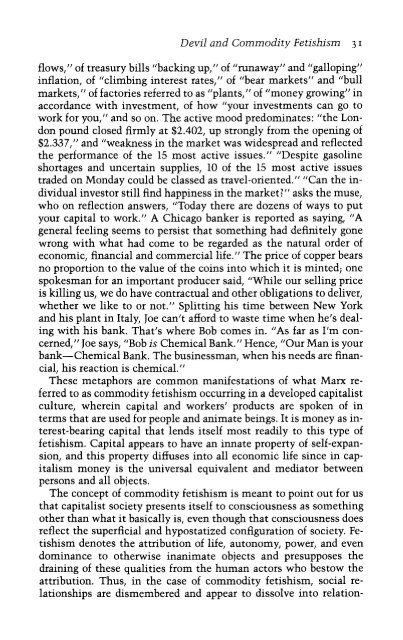The Devil and Commodity Fetishism in South America - autonomous ...
The Devil and Commodity Fetishism in South America - autonomous ...
The Devil and Commodity Fetishism in South America - autonomous ...
You also want an ePaper? Increase the reach of your titles
YUMPU automatically turns print PDFs into web optimized ePapers that Google loves.
<strong>Fetishism</strong> <strong>and</strong> Dialectical Deconstiuction j<br />
ject-relations beholden to market<strong>in</strong>g strategies. Because the ethnography<br />
with which I am deal<strong>in</strong>g perta<strong>in</strong>s largely to what are sometimes<br />
called precapitalist societies, these dangers become press<strong>in</strong>g<br />
problems. For such social formations easily seduce <strong>in</strong> precisely this<br />
problematic way the m<strong>in</strong>d tra<strong>in</strong>ed <strong>and</strong> honed by capitalist <strong>in</strong>stitutions.<br />
Set aga<strong>in</strong>st the images that capitalist society presents of itself,<br />
precapitalist life can appeal (or frighten) on account of its apparent<br />
idealism <strong>and</strong> the enchantment of its universe by spirits <strong>and</strong> phantoms<br />
that display the course of the world <strong>and</strong> its salvation. Furthermore,<br />
precapitalist societies acquire the burden of hav<strong>in</strong>g to satisfy<br />
our alienated long<strong>in</strong>gs for a lost Golden Age.<br />
Faced with the unsatisfactory <strong>and</strong> <strong>in</strong>deed politically motivated<br />
paradigms of explanation that have been <strong>in</strong>s<strong>in</strong>uated <strong>in</strong>to the mental<br />
fiber of modern capitalist society—its mechanical materialism as<br />
well as its alienated forms <strong>in</strong> religion <strong>and</strong> nostalgia—what counterstrategy<br />
is available for the illum<strong>in</strong>ation of reality that does not<br />
<strong>in</strong> some subtle way replicate its rul<strong>in</strong>g ideas, its dom<strong>in</strong>ant passions,<br />
<strong>and</strong> its enchantment of itself? As I see it, this question is both necessary<br />
<strong>and</strong> Utopian. It is essential to pose the challenge, but it is Utopian<br />
to believe that we can imag<strong>in</strong>e our way out of our culture without<br />
act<strong>in</strong>g on it <strong>in</strong> practical ways that alter its social <strong>in</strong>frastructure.<br />
For this reason, what I call negative criticism is all that is possible,<br />
apt, <strong>and</strong> dem<strong>and</strong>ed at the <strong>in</strong>tellectual level. This implies that we adhere<br />
to a mode of <strong>in</strong>terpretation that is unremitt<strong>in</strong>gly aware of its<br />
procedures <strong>and</strong> categories,- thus, our thought is exposed to itself as a<br />
process of escalat<strong>in</strong>g self-criticism <strong>in</strong> which self-consciousness f<strong>in</strong>ally<br />
establishes itself <strong>in</strong> the realm of the concrete phenomena that<br />
<strong>in</strong>itiated our <strong>in</strong>quiry <strong>and</strong> led to the first empirical abstractions <strong>and</strong><br />
distortions of it. But if the mode of comprehension that we espouse<br />
is this ever-widen<strong>in</strong>g network of self-aware description of the concrete,<br />
then it must also be clearly understood, as Fredric Jameson<br />
has <strong>in</strong>sisted, that this self-awareness must be acutely sensitive to<br />
the social roots <strong>and</strong> historicity of the abstractions that we employ at<br />
any stage of the process (1971).<br />
This self-awareness prefigures the concept of culture <strong>and</strong> the theory<br />
of perception that I employ, as <strong>in</strong>voked by Sidney Hook's early<br />
<strong>in</strong>terpretation of Marxist epistemology. "What is beheld <strong>in</strong> perception,"<br />
he writes, "depends just as much upon the perceiver as upon<br />
the antecedent causes of perception. And s<strong>in</strong>ce the m<strong>in</strong>d meets the<br />
world with a long historical development beh<strong>in</strong>d it, what it sees, its<br />
selective reaction, the scope <strong>and</strong> manner of its attention are to be expla<strong>in</strong>ed,<br />
not merely as physical or biological fact, but as social fact as<br />
well" (1933 :89). It is, of course, the peculiar <strong>and</strong> specific character of
















